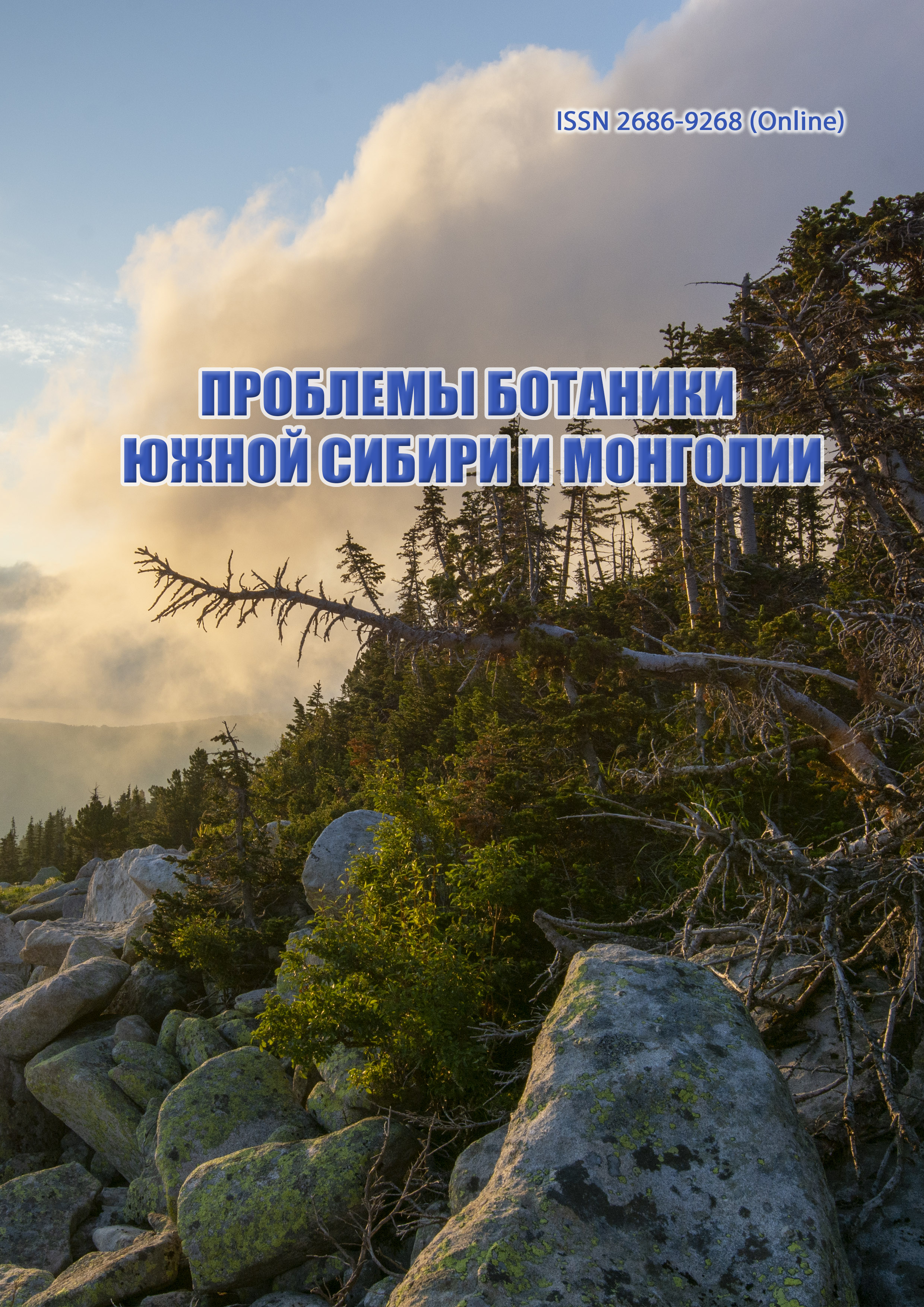Ecological assessment using diatom community in Avarga Toson Lake (Mongolia)
УДК 582.26:574.21(282.2)(517.3)
DOI:
https://doi.org/10.14258/pbssm.2021106Keywords:
Антропогенный фактор, богатство диатомовых водорослей, подвижные диатомеи, озеро Аварга ТосонAbstract
A total of 32 diatom species were recorded in Avarga Toson Lake. Motile diatom species are dominatingin diatom communities. The species composition of two coexisted lakes is markedly different. Diatom richness, speciescomposition, and dominant species indicate that Burd lake is polluted by livestock grazing or domestic pollution, andToson Lake is polluted by human activities with high sediment accumulation at the bottom.
Downloads
Download data is not yet available.
References
Berthon V., Alric B., Rimet F., Perga M-E. 2014. Sensitivity and responses of diatoms to climate warming in lakes heavily influenced by humans // Freshwater Biology, 2014. – Vol. 59. – P. 1755–1767. DOI: 10.1111/fwb.12380
Blindow I., Dietrich J, Möllmann N., Schubert H. Growth, photosynthesis and fertility of Chara aspera under different light and salinity conditions // Aquatic Botany, 2003. – Vol. 76. – P. 213–234. DOI: 10.1016/S0304-3770(03)00053-6
Döll P., Zhang J. Impact of climate change on freshwater ecosystems: a global-scale analysis of ecologically relevant river flow alterations // Hydrology and Earth System Sciences, 2010. – Vol. 14. – P. 783–799. DOI: 10.5194/hess-14-783-2010, 2010.
Kang S., Hong S. Y. Assessing Seasonal and Inter-Annual Variations of Lake Surface Areas in Mongolia during 2000- 2011 Using Minimum Composite MODIS NDVI // PLoS ONE, 2016. – Vol. 11(3), e0151395. DOI: 10.1371/journal.pone.0151395
Mandakh U., Ganba, D., Batsaikhan B., Dalantai S., Adiya Z., Bayasgalan N, Bayarsaikhan S., Borjigidai A., Long C. Impacts of Rapid Changes of Land Cover and Intensive Human Activities on Avarga Toson Lake Area, Mongolia // Sustainability, 2020. – Vol. 12, 6070. DOI:10.3390/su12156070
Martín G., Fernández M. R. Diatoms as indicators of water quality and ecological status: sampling, analysis and some ecological remarks. In: Dr Voudouris (ed) Ecological water quality—water treatment and reuse. 2012. InTechDOI: 10.5772/33831
Trobajo R., Mann D. G. A rapid cleaning method for diatoms // Diatom Research, 2019. – Vol. 34(2). – P. 115–124. DOI: 10.1080/0269249X.2019.1637785
Smucker N. J., Vis M. L. Using diatoms to assess human impacts on streams benefits from multiple habitat sampling// Hydrobiologia, 2010. – Vol. 654. – P. 93–109. DOI: 10.1007/s10750-010-0373-x
Rühland K. M., Paterson A. M., Smol J. P. Lake diatom responses to warming: reviewing the evidence // Journal of Paleolimnology, 2015. – Vol. 54. – P. 1–35. DOI: 10.1007/s10933-015-9837-3
Tuvikene L., Nõges T., Nõges P. 2011. Why do phytoplankton species composition and “traditional” water quality parameters indicate different ecological status of a large shallow lake? // Hydrobiologia, 2011. – Vol. 660. – P. 3–15. DOI:10.1007/s10750-010-0414-5
Van Dam H., Mertens A., Sinkeldam J. A coded checklist and ecological indicator values of freshwater diatoms from The Netherlands // Netherlands Journal of Aquatic Ecology, 1994. – Vol. 28. – P. 117–133. DOI: 10.1007/BF02334251
Yadamsuren G., Tseveendorj D. The Amount of Skin Diseases Treated by the Clay of Avarga Toson Lake; National Center for Dermatology. – Ulaanbaatar: Ulsiin Hevleliin Gazar, 1980. – P. 12. (In Mongolian)
Blindow I., Dietrich J, Möllmann N., Schubert H. Growth, photosynthesis and fertility of Chara aspera under different light and salinity conditions // Aquatic Botany, 2003. – Vol. 76. – P. 213–234. DOI: 10.1016/S0304-3770(03)00053-6
Döll P., Zhang J. Impact of climate change on freshwater ecosystems: a global-scale analysis of ecologically relevant river flow alterations // Hydrology and Earth System Sciences, 2010. – Vol. 14. – P. 783–799. DOI: 10.5194/hess-14-783-2010, 2010.
Kang S., Hong S. Y. Assessing Seasonal and Inter-Annual Variations of Lake Surface Areas in Mongolia during 2000- 2011 Using Minimum Composite MODIS NDVI // PLoS ONE, 2016. – Vol. 11(3), e0151395. DOI: 10.1371/journal.pone.0151395
Mandakh U., Ganba, D., Batsaikhan B., Dalantai S., Adiya Z., Bayasgalan N, Bayarsaikhan S., Borjigidai A., Long C. Impacts of Rapid Changes of Land Cover and Intensive Human Activities on Avarga Toson Lake Area, Mongolia // Sustainability, 2020. – Vol. 12, 6070. DOI:10.3390/su12156070
Martín G., Fernández M. R. Diatoms as indicators of water quality and ecological status: sampling, analysis and some ecological remarks. In: Dr Voudouris (ed) Ecological water quality—water treatment and reuse. 2012. InTechDOI: 10.5772/33831
Trobajo R., Mann D. G. A rapid cleaning method for diatoms // Diatom Research, 2019. – Vol. 34(2). – P. 115–124. DOI: 10.1080/0269249X.2019.1637785
Smucker N. J., Vis M. L. Using diatoms to assess human impacts on streams benefits from multiple habitat sampling// Hydrobiologia, 2010. – Vol. 654. – P. 93–109. DOI: 10.1007/s10750-010-0373-x
Rühland K. M., Paterson A. M., Smol J. P. Lake diatom responses to warming: reviewing the evidence // Journal of Paleolimnology, 2015. – Vol. 54. – P. 1–35. DOI: 10.1007/s10933-015-9837-3
Tuvikene L., Nõges T., Nõges P. 2011. Why do phytoplankton species composition and “traditional” water quality parameters indicate different ecological status of a large shallow lake? // Hydrobiologia, 2011. – Vol. 660. – P. 3–15. DOI:10.1007/s10750-010-0414-5
Van Dam H., Mertens A., Sinkeldam J. A coded checklist and ecological indicator values of freshwater diatoms from The Netherlands // Netherlands Journal of Aquatic Ecology, 1994. – Vol. 28. – P. 117–133. DOI: 10.1007/BF02334251
Yadamsuren G., Tseveendorj D. The Amount of Skin Diseases Treated by the Clay of Avarga Toson Lake; National Center for Dermatology. – Ulaanbaatar: Ulsiin Hevleliin Gazar, 1980. – P. 12. (In Mongolian)
Downloads
Published
2021-09-22
Issue
Section
Статьи
How to Cite
Ecological assessment using diatom community in Avarga Toson Lake (Mongolia): УДК 582.26:574.21(282.2)(517.3). (2021). Проблемы ботаники Южной Сибири и Монголии, 20(1), 526-530. https://doi.org/10.14258/pbssm.2021106

